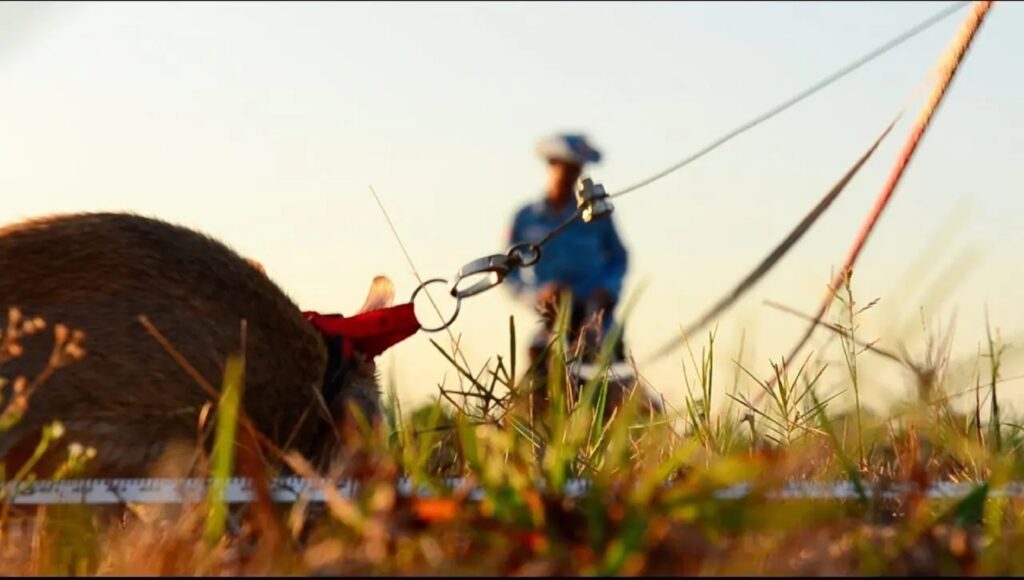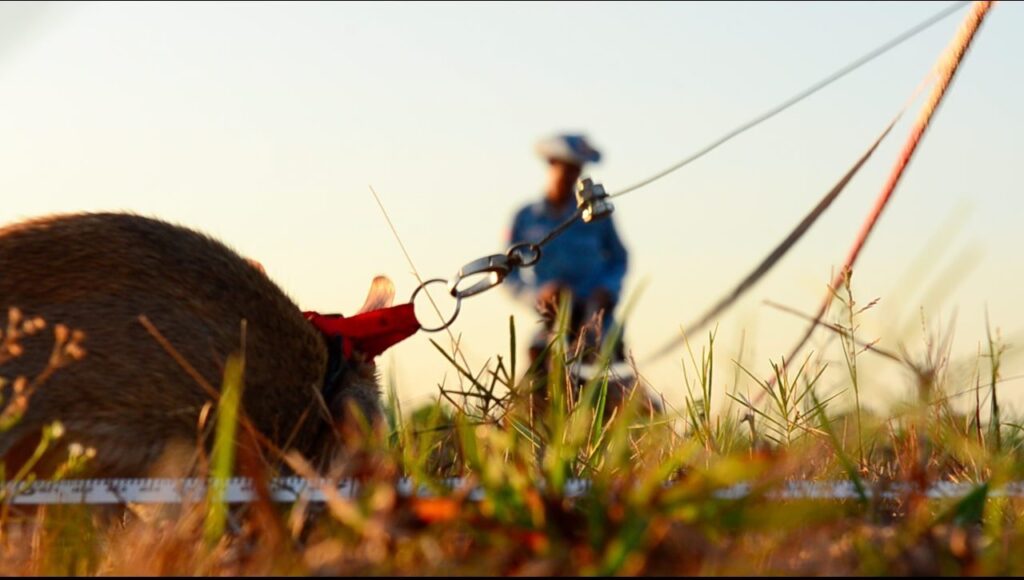
Fejos Postdoctoral Fellow: Darcie DeAngelo
“Learning to Love Rats” is a collaborative ethnographic film with three deminers who find unexpected partnerships with an animal normally understood as a pest: a rat. They use their military know-how to detect landmines in the minefields of Cambodia, but also call on the help of Giant Gambian Pouched rats who sniff for TNT. These rats were introduced to Cambodia in 2015 and the ethnographic footage comes from that time, capturing the three deminers’ developing relationships with their rats. Co-produced with Malenn, Chamroeun, and Sokhiem, the film allows the deminers tell the story of their introduction to the landmine detection rats and the struggles they had to learn to love them. These stories are reflected by the footage that offers sensory ethnographic details of their learning processes. The rats and deminers learn how to navigate landmines and new relationships together, becoming favorites, “little sisters,” “best friends,” and beloveds. The images of the film and its style depict the jarring nature of a postwar ecology: contrasts of meditative and beautiful minefields, workplaces where colleagues make meals for each other and love their rats, all while under threat of deadly potential explosions, undermining straightforward definitions of concepts like peace and nature.
Since January 2024, I have organized and logged footage, collaborated with filmmakers, collaborated with co-producers, and put together an assembly cut of the film’s key scenes. While long-distance collaboration with the co-producers, Malenn, Chamroeun, and Sokhiem, has been difficult while they are working full-time on the minefields, there are several items we agree on. These items also align with the original reviewers who assessed the proposal: audio quality must be improved and thus re-recorded; some scenes should be re-shot. Collaboration has allowed for what Faye Ginsburg calls the parallax effect, where new ideas about the film’s narrative and style have emerged through the combined media practice of observational ethnographic film predilections from myself and the narrative stories my co-producers encourage (1994). We look forward to continued work on this film with planned re-shoots for audio as well as new scenes to fit the new structure. Some of these scenes are fictionalizations a few collaborators have provocatively suggested. These planned reshoots are scheduled around Cambodian collaborators’ calendars and will take place in 2025.

As outlined in my proposal, I divided the nine-month tenure of the fellowship into three parts. The first three months, I logged and organized the hundreds of hours of footage from my time conducting ethnographic fieldwork in Cambodian minefields with rats from 2015-2016. The next three months, I have had online conversations with my co-producers after editing sequences and sending them clips. The final three months have been collating their notes and sharing sequences with fellow ethnographic filmmakers as I composed the assembly cuts. Based on my collaborations, there are various scenes that need to be reshot, including the interviews with the three main characters of the film and multiple scenes that my co-producers and I believe are essential to the structure we have decided upon for the film.
I catalogued footage according to scenes with the three co-producers as well as the steps of the demining process: prepping the rats for the minefield; demining with the rats; and putting the rats away in the kennels after work. My collaborators and I also discussed the importance of quotidian scenes in the minefield such as when the deminers are making meals together. We felt that many scenes needed to be added to the narrative such as the following: the nightly walks with the rats on their leashes; the trips to the village market when the deminers buy groceries for their meals; and the deminers eating meals together. These collaborations have allowed more ideas to emerge about the structure of the film. While the central story remains the same, the process of the deminers as they learned to love the rats divided into three parts with each of the deminers having fifteen minute sequences about their particular relationships with the rats, the structure now moves with an overarching narrative along about the time lapsed in the development of the organization based on different settings. The first sequence depicts the training period on a faux minefield; the second with the deminers working on a real minefield; and the third takes place in the tourism center in Siem Reap with retired rats.
Malenn’s story begins the film and she introduces the subject of demining in Cambodia as well as her personal biography. Intertitles, as seen in the trailer, provide historical background of landmines in Cambodia. She also introduces us to the idea of landmine detection rats, which were implemented in Cambodia in 2015. With her 15-minute sequence, we watch as deminers learn to handle the landmine detection rats and also how she learns to love them. She cradles her rats and deminers call them “littlest ones” and “babies.” Malenn calls her favorite rat, Isaac, “her little sister,” and explains that it is because she loves him. Interwoven within her sequence is her going to the market and buying groceries and cooking with her colleagues. After she successfully works a day with her rats, this first sequence ends with the dinner the deminers eat together.
The next two sequences introduce the next two co-producers. The first scene of the second sequence is Chamroeun massaging sunblock on a rat’s ears and tail before dawn. This sequence will then move on to Chamroeun’s interview with his backstory in the military and his success at becoming a landmine detection rat handler. The majority of this sequence takes place on a minefield, rather than the training grounds where Malenn’s story takes place. It ends with the nightly leashed walks with the deminers and the rats. The third and final sequence takes place in the Siem Reap tourism center with Sokhiem, a deminer who sometimes works as a demonstrator there for the tourists. Sokhiem discusses their developing relationship with the rats in an interview and also the story of the rat retirements in Siem Reap. Once the rats age out of their work, they live in kennels in Siem Reap and demonstrate landmine detection on a sandpit that is meant to mimic minefield detection. This sequence ends with the rats, Sokhiem, and Sokhiem’s girlfriend cuddling.
The planned reshoots will take place in the spring of 2025, based on the co-producers’ working schedules. Most of the collaborators wanted to put more of the human story alongside the nonhumans whereas the original footage has an emphasis on the rats. These moments will be included with the stories about the humans. We have enough footage of rats and the sensorial encounters of tranquility and affection between rats and humans. As the reviewers originally suggested, the audio for the interviews needs to be reshot and the collaborators wanted more of their everyday lives included. There is one experimental idea that may or may not be followed up on when reshooting these and that is the idea of playacting the moment when a spirit killed a rat on the minefield, but that is something that will have to be planned in the re-editing in the summer of 2025.
The plans for distribution have not changed but they have been pushed forward to allow for final say from all the co-producers and consent for all filmed parties. There are several Cambodian film festivals where we will submit the film as well as the Society for Visual Anthropology Film and Media Festival 2026. We plan on sending the completed film to Documentary Educational Resources (DER) in 2026 for review. We have already discussed which libraries in Cambodia should retain copies and my three co-producers and I have brainstormed that free copies should be available in Cambodian repositories such as the APOPO Visitor Center, the Bophana Film Center (a Cambodian-run film archive) and the Center for Khmer Studies. These final distribution steps will begin in late 2025 and continue in 2026.